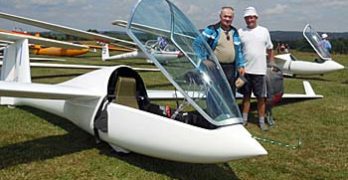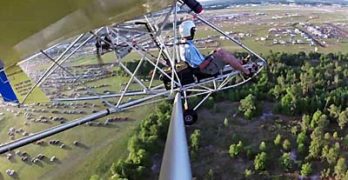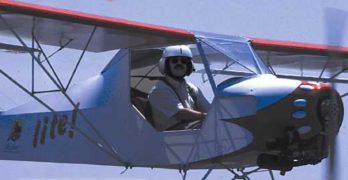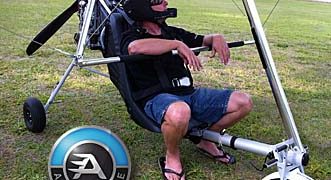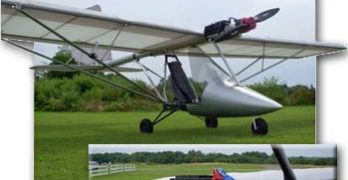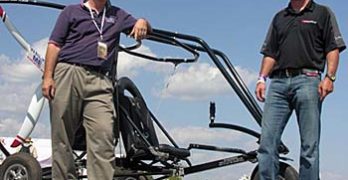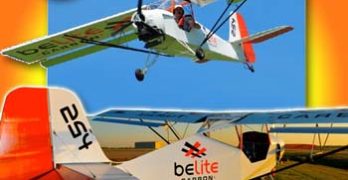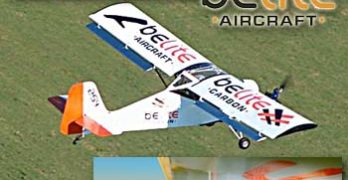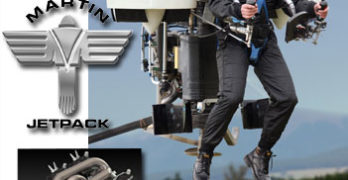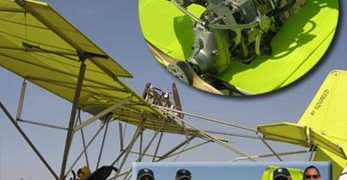For your weekend enjoyment — and because I am a soaring enthusiast … plus I was sent some interesting photos — consider this slick Part 103 glider, or motorglider (photo). Radek Hucik sent photos of the aircraft performing at a Czech soaring content, where it placed 12th out of 34 competitors. Considering most of the others appear to be conventional sailplanes, one that meets Part 103 at much less weight did well. A high end sailplane can hit or exceed a 50:1 glide angle. This is an amazing performance mark, which translates to flying nearly ten miles from only 1,000 feet of altitude. The XS-12 Saggita manages 35:1 (more specs below) and that is a noteworthy achievement for such a light aircraft. Radek wrote, “[This is] a powered glider that my colleagues and I have developed over the past 20 months. The glider is designed so that it meets Federal Aviation Regulations Part 103 [for] Ultralight Vehicles.
Search Results for : Part 103
Not finding exactly what you expected? Try our advanced search option.
Select a manufacturer to go straight to all our content about that manufacturer.
Select an aircraft model to go straight to all our content about that model.
Zigolo Cracks the China Market as Part 103!
I didn’t see this one coming. Maybe you didn’t either? In the new millennia gold rush represented by companies either being bought by Chinese businesses or gaining investment from wealthy Chinese business people or by setting up shop to sell in China (or even Cessna’s ill-fated effort to have their Skycatcher manufactured in China), one element I’ve never heard of is Part 103 in China. This least-regulated-of-all aviation category is solely an American thing, isn’t it? Well … yes and no. Germany has opened the door to a Part 103-like development in that country under the 120-kilogram class (using a number that is 264 pounds or very similar to Part 103’s 254-pound empty weight limit). England has their SSDR class (SSDR being the abbreviation for Single Seat De-Regulated). Despite following those developments, I’ve never heard a word about China and any less-regulated sector.
“The first Zigolo in China was introduced to the public in that nation on July 17th at the Jingmen Airshow,” reported representative Chip W.
Part 103 Carbon 254
[UPDATE — fall 2009: This article about the Kitfox Lite refers to a company now several years out of business. The new Kitfox producer sold the Kitfox Lite design to Kansas entrepreneur, James Wiebe. His company, Belite Aircraft, now produces the Belite Carbon 254 (and other variations) and has significantly changed structure with carbon fiber components to lighten the weight, assuring that it meets Part 103. For the latest info on their offerings, contact the company directly.
Information in this article, while similar to what Belite Aircraft produces today, will not be identical to the new model. –Dan]
While it may have been a long time coming, SkyStar Aircraft – the builder of the extremely popular Kitfox series – has done their Kitfox Lite version right. It was easily worth the wait.
While the Kitfox Lite and Avid Aircraft’s Champion were both flying regularly last summer, SkyStar elected not to have the plane flown for an Ultralight Flying!
Four-Stroke Part 103 Ultralight? Yes! And Fun…
Sometimes you’re in the right place at the right time. Well, OK, I’m biased but I think pretty much any time at Wallaby Ranch — the iconic hang gliding facility south of Disney Orlando — is a good time. When it also happens to be “Demo Days,” Wallaby is a jumping place! Demo Days is a longstanding activity where the California manufacturer, Wills Wing, brings its newest hang gliders by the truckload so that any qualified pilots can fly them for purchase evaluation. Lots of other folks show up because it’s fun and exciting but also because organizers hold the event right before Sun ‘n Fun starts.
Wallaby customers compose the perfect crowd for introducing a lightweight trike that can be flown for soaring fun. Airborne Australia is the down under manufacturer of both hang gliders and a successful line of trikes; they own SLSA status for their XT-912 and XT-912 Outback.
Part 103 Enthusiasm Continues; Welcome E-Spyder!
Part 103 continues to step from the shadow of Light-Sport Aircraft. We’ve had aviation’s simplest rule (worldwide!) for 27 years and with few exceptions, most of those years saw Part 103 producers laboring in near-obscurity. *** Now, however, a new flurry of activity has developed at the beautiful intersection of genuinely lightweight aircraft with electric power. The very latest to roll into the spotlight is Flightstar‘s E-Spyder, which took its first flight today. E-power from Yuneec in China meets an all-American airframe. The accompanying photos show what a clean matchup these components achieve. *** Flightstar mounted the twin lithium polymer battery packs on either side of the design’s robust main fuselage tube. Electric motors are more user-friendly in nearly every way, but you have some new learning to do. For example, experts advise never allowing lithium polymer batters to drain completely. Fortunately, the Yuneec controlling hardware provides warning systems to help you manage this task.
Electric Part 103 Ultralights and Battery Science
I am not alone in thinking Part 103 ultralight aircraft are the ideal platform for initial development of electric powered aircraft. Sure, someday you’ll be able to fly your 2-4 seater for 300-400 miles or more, recharge in the time it takes you to use the facilities, and be on your way again. But today, electric-powered Part 103s are available. *** You can buy the eSpyder for under $30,000 and fly for an hour or more. Accompanying photos show the Voyager ElectraChute from Powrachute, another possibility. Or, how about an electric trike? Longer-trip capability depends on better batteries. And thanks to a multibillion-dollar push from the auto industry, battery tech should develop rapidly. Ready for a short science lesson?*** According to an article in Nature Nanotechnology, researchers at MIT have developed a new method of adding carbon nanotubes to lithium-ion batteries that give the batteries the best characteristics of both capacitors and traditional lithium-ion batteries while simultaneously increasing their energy storage.
Belite’s Carbon Fiber Part 103 Ultralight Vehicle
If you’ve been around aviation long enough you’ve heard the Q&A: “Know how to make a small fortune in aviation? Start with a large one!” Yet aviation can always use fresh talent, so welcome former tech entrepreneur, James Wiebe, turned aviation businessman. From his days building Mac peripherals under the name Newer Technology (and reaching sales of $60 million), Wiebe sold his tech enterprises and, in January 2009, bravely launched Belite Aircraft. The first flight came July 4th.
Wiebe chose to incorporate stronger, lighter carbon fiber technologies to replace steel, wood, and aluminum. The result is a three-axis, full-cockpit airplane with a full instrument panel that can be built to weigh less than Part 103’s 254-pound maximum. Though employing plenty of costly carbon fiber including on the firewall, Belite uses a welded steel frame for strength and safety. The premium Belite 254 CF includes carbon fiber wing spars and ribs, hydraulic brakes, aluminum wheels, full flight instrumentation, built in transceiver, a bigger 45-hp engine, enhanced electrical system, and a Gizmo GPS dock.
Part 103 Belite Flies; Electric Power Coming
Part 103 ultralights seem eclipsed by the attention awarded to Light-Sport Aircraft. But a Wichita tech entrepreneur who sold his business is now pursuing aviation focused on the airplane formerly known as the Kitfox Lite. *** James Wiebe bought the rights to the single seater, opened shop as Belite Aircraft, and immediately started replacing aluminum and wood components with carbon fiber. The result is a genuinely light aircraft than can make Part 103 with several pounds to spare. *** On July 4th, as America was blowing off fireworks, James fired up his 28-horsepower Zanzottera MZ-34 engine to make his maiden flight. “While the rest of the country was focused on celebrating independence, I was experiencing it, making lazy circles in the sky above Jabara Airport,” Wiebe expressed. As flown, the airplane weighed approximately 245 pounds and that included the optional rear window and a full VFR panel.
Martin Jetpack as a Part 103 Ultralight
The Martin Jetpack flew at Oshkosh in a carefully controlled environment (photo). Two people held special “training wheel” grips on each side and Jetpack never lifted more than a couple feet off the ground. If you weren’t in the front row of the airshow demonstration you might have missed the flight (although not the noise). *** But Jetpack did fly and can qualify as a Part 103 ultralight, according to New Zealand developer Glenn Martin. Besides being the most compact Ultralight Vehicle at 5 x 5 x 5 feet, it’s probably the most expensive at $100,000. Martin said he has been working on the Jetpack for 30 years also developing a 200-hp two-stroke piston engine that pumps air through ducted fans to adjustable steering vanes to control flight. Jetpack specs *** A Jetpack pilot controls pitch and roll with the left joystick. A right stick is both a twist grip throttle and pivoting yaw control.
Rotary Power for M-Squared’s Part 103 Ultralight
In the late 1970s, Mazda popularized the rotary engine for their RX-7 sports car. Such engines are particularly known for their smooth running operation. Many aviators can appreciate low-vibration powerplants but especially those flying the lightest of recreational aircraft, namely Part 103 machines. *** Now, M-Squared has partnered to offer such a combination. Revolution Rotary Engines Inc., a Canadian-based manufacturing company located in Markham, Ontario connected with M-Squared‘s Paul Mather to exploit the possibilities of rotary power. At Sun ‘n Fun 2008, M-Squared showed a single place, strutted Breese with the R301A single cylinder rotary engine supplying 35 horsepower. Installed on M-Squared’s lightweight Breese SS (single seat), the aircraft is said to remain within 103’s tight parameters (assuming the buyer does not insist on options and accessories that would bump it over weight). *** The single rotor aircraft engine looks compact and weighs a reported 40 pounds.
- « Previous Page
- 1
- …
- 3
- 4
- 5
- 6
- 7
- …
- 53
- Next Page »


